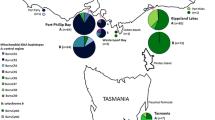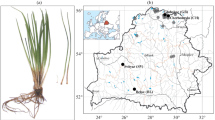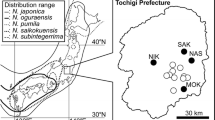Abstract
Randomly amplified polymorphic DNA (RAPD) banding patterns were compared between samples of the netted dogwhelk Nassarius reticulatus from 11 locations along the NW Iberian Peninsula coast. To detect if rias (estuaries formed by drowned river valleys) might promote genetic differentiation, five sampling sites were located within a ria (ria of Muros) and the remaining six were scattered along open-coast areas at increasing distances from the ria mouth. Population differentiation statistics (Φ-values) were estimated using a hierarchical analysis of molecular variance (AMOVA) with samples sorted into two groups: open-coast and ria populations. Despite a high potential to disperse, AMOVA demonstrated a modest, statistically significant genetic heterogeneity among N. reticulatus populations. Most of the genetic structure resided in differences among open-coast populations; ria populations were genetically homogeneous. No obvious geographical pattern was detected for the pairwise genetic distances (non-metric multidimensional scaling; UPGMA tree; Mantel test). Unlike previous studies with other species at a variety of estuarine systems other than rias, there was no evidence that the ria of Muros may enhance the genetic divergence of N. reticulatus populations. This discrepancy is discussed in relation to the biological features of the species (high dispersal potential and a preference for mid-low estuarine habitat) and the strong hydrographic connectivity between ria and neighbouring off-shore waters.




Similar content being viewed by others
References
Alvarez-Salgado XA, Gago J, Miguez BM, Gilcoto M, Perez FF (2000) Surface waters of the NW Iberian margin: upwelling on the shelf versus outwelling of upwelled waters from the Rias Baixas. Estuar Coast Shelf Sci 51:821–837
Alvarez-Salgado XA, Figueiras FG, Perez FF, Groom S, Nogueira E, Borges AV, Chou L, Castro CG, Moncoiffe G, Rios AF (2003) The Portugal coastal counter current off NW Spain: new insights on its biogeochemical variability. Prog Oceanogr 56:281–321
Avise JC (1992) Molecular population structure and the biogeographic history of a regional fauna: a case history with lessons for conservation biology. Oikos 63:62–76
Barnett PRO, Hardy BLA, Watson J (1980) Substratum selection and egg-capsule deposition in Nassarius reticulatus (L.). J Exp Mar Biol Ecol 45:95–103
Barreiro R, González R, Quintela M, Ruiz JM (2001) Imposex, organotin bioaccumulation and sterililty of female Nassarius reticulatus in polluted areas of NW Spain. Mar Ecol Prog Ser 218:203–212
Barroso CM, Moreira MH (1998) Reproductive cycle of Nassarius reticulatus in the Ria de Aveiro, Portugal: implications for imposex studies. J Mar Biol Assoc UK 78:1233–1246
Bilton DT, Paula J, Bishop JDD (2002) Dispersal, genetic differentiation and speciation in estuarine organisms. Estuar Coast Shelf Sci 55:937–952
Bohonak AJ (1999) Dispersal, gene flow, and population structure. Q Rev Biol 74:21–45
Bohonak AJ (2002) IBD (Isolation by distance): a program for analysis of isolation by distance. J Hered 93:153–154
Bossart JL, Prowell DP (1998) Genetic estimates of population structure and gene flow: limitations, lessons and new directions. Trends Ecol Evol 13:202–206
Botsford LW, Micheli F, Hastings A (2003) Principles for the design of marine reserves. Ecol Appl 13:S25–S31
Bryan GW, Burt GR, Gibbs PE, Pascoe PL (1993) Nassarius reticulatus (Nassariidae: Gastropoda) as an indicator of tributyltin pollution before and after TBT restrictions. J Mar Biol Assoc UK 73:913–929
De Wolf H, Blust R, Backeljau T (2004) The use of RAPD in ecotoxicology. Mut Res/Rev Mut Res 566:249–262
Edmands S, Moberg PE, Burton RS (1996) Allozyme and mitochondrial DNA evidence of population subdivision in the purple sea urchin Strongylocentrotus purpuratus. Mar Biol 126:443–450
Evans G, Prego R (2003) Rias, estuaries and incised valleys: is a ria an estuary? Mar Geol 196:171–175
Excoffier L, Smouse PE, Quattro JM (1992) Analysis of molecular variance inferred from metric distances among DNA haplotypes: application to human mitochondrial DNA restriction data. Genetics 21:479–491
Felsenstein J (2004) PHYLIP (Phylogeny Inference Package) v. 3.6. Distributed by the author at http://evolution.gs.washington.edu/phylip.html, Department of Genome Sciences, University of Washington, Seattle
Flowers JM, Burton RS, Schroeter SC (2002) The recruitment sweepstakes has many winners: genetic evidence from the sea urchin Strongylocentrotus purpuratus. Evolution 56:1445–1453
Fretter V, Shale D (1973) Seasonal-changes in population density and vertical distribution of prosobranch veligers in offshore plankton at Plymouth. J Mar Biol Assoc UK 53:471–492
Fretter V, Graham A (1994) British prosobranch molluscs: their functional anatomy and ecology, 2nd edn. Ray Society, London
Grosberg R, Cunningham CW (2001) Genetic structure in the sea: from populations to communities. In: Bertness MD, Gaines S, Hay ME (eds) Marine community ecology. Sinauer Associates, Sunderland, pp 61–84
Grosberg RK, Levitan DR, Cameron BB (1996) Characterization of genetic structure and genealogies using RAPD-PCR markers: a random primer for the novice and nervous. In: Ferraris JD, Palumbi SR (eds) Molecular zoology: advances, strategies and protocols. Wiley-Liss, New York, pp 67–100
Hadrys H, Balick M, Schierwater B (1992) Applications of random amplified polymorphic DNA (RAPD) in molecular ecology. Mol Ecol 1:55–63
Haig SM, Rhymer JM, Heckel DG (1994) Population differentiation in randomly amplified polymorphic DNA of red-cockaded woodpeckers Picoides borealis. Mol Ecol 3:581–595
Hedgecock D (1994) Does variance in reproductive success limit effective population size of marine organisms? In: Beaumont AR (ed) Genetics and evolution of aquatic organisms. Chapman & Hall, London, pp 122–134
Heipel DA, Bishop JDD, Brand AR, Thorpe JP (1998) Population genetic differentiation of the great scallop Pecten maximus in western Britain investigated by randomly amplified polymorphic DNA. Mar Ecol Prog Ser 162:163–171
Hellberg ME, Burton RS, Neigel JE, Palumbi SR (2002) Genetic assessment of connectivity among marine populations. Bull Mar Sci 70:273–290
Huang BX, Peakall R, Hanna PJ (2000) Analysis of genetic structure of blacklip abalone (Haliotis rubra) populations using RAPD, minisatellite and microsatellite markers. Mar Biol 136:207–216
Huff DR, Peakall R, Smouse PE (1993) RAPD variation within and among natural populations of outcrossing buffalograss [Buchloe dactyloides (Nutt.) Engelm.]. Theor Appl Genet 86:927–934
Johnson MS, Black R (1982) Chaotic genetic patchiness in an inter-tidal limpet, Siphonaria sp. Mar Biol 70:157–164
Johnson MS, Black R (1991) Genetic subdivision of the intertidal snail Bembicium vittatum (Gastropoda: Littorinidae) varies with habitat in the Houtman Abrolhos Islands, Western Australia. Heredity 67:205–213
Johnson MS, Wernham J (1999) Temporal variation of recruits as a basis of ephemeral genetic heterogeneity in the western rock lobster Panulirus cygnus. Mar Biol 135:133–139
Jones GP, Milicich MJ, Emslie MJ, Lunow C (1999) Self-recruitment in a coral reef fish population. Nature 402:802–804
Lambeck RHD (1984) Dynamics, migration and growth of Nassarius reticulatus (Mollusca: Prosobranchia) colonizing saline lake Grevelingen (SW Netherlands). Neth J Sea Res 18:395–417
Lambert WJ, Todd CD, Thorpe JP (2003) Genetic population structure of two intertidal nudibranch molluscs with contrasting larval types: temporal variation and transplant experiments. Mar Biol 142:461–471
Lebour MV (1931) The larval stages of Nassarius reticulatus and Nassarius incrassatus. J Mar Biol Assoc UK 17:797–818
Lewontin RC (1972) The apportionment of human diversity. Evol Biol 6:381–394
Li G, Hedgecock D (1998) Genetic heterogeneity, detected by PCR-SSCP, among samples of larval Pacific oysters (Crassostrea gigas) supports the hypothesis of large variance in reproductive success. Can J Fish Aquat Sci 55:1025–1033
Lynch M, Milligan BG (1994) Analysis of population genetic structure with RAPD markers. Mol Ecol 3:91–99
Mantel N (1967) The detection of disease of clustering and a generalized regression approach. Cancer Res 27:209–220
Miller MP (1997) Tools for population genetic analyses (TFPGA) 1.3: a Windows program for the analysis of allozyme and molecular population genetic data. (Computer software distributed by author)
Moberg PE, Burton RS (2000) Genetic heterogeneity among adult and recruit red sea urchins, Strongylocentrotus franciscanus. Mar Biol 136:773–784
Nei M (1987) Molecular evolutionary genetics. Columbia University Press, New York
Palumbi SR (1994) Genetic divergence, reproductive isolation, and marine speciation. Annu Rev Ecol Syst 25:547–572
Palumbi SR (2003) Population genetics, demographic connectivity, and the design of marine reserves. Ecol Appl 13:S146–S158
Palumbi SR, Gaines SD, Leslie H, Warner RR (2003) New wave: high-tech tools to help marine reserve research. Front Ecol Evol 1:73–79
Parsons KE (1996) The genetic effects of larval dispersal depend on spatial scale and habitat characteristics. Mar Biol 126:403–414
Perrin C, Wing SR, Roy MS (2004) Effects of hydrographic barriers on population genetic structure of the sea star Coscinasterias muricata (Echinodermata, Asteroidea) in the New Zealand fiords. Mol Ecol 13:2183–2195
Raymond M, Rousset F (1995) An exact test for population differentiation. Evolution 449:1280–1283
Schneider S, Roessli D, Excoffier L (2000) Arlequin ver. 2.000: a software for population genetics data analysis. Genetics and Biometry Laboratory, University of Geneva, Geneva, Switzerland
Shanks AL, Grantham BA, Carr MH (2003) Propagule dispersal distance and the size and spacing of marine reserves. Ecol Appl 13:S159–S169
Skroch P, Nienhuis J (1995) Impact of scoring error and reproducibility of RAPD data on RAPD based estimates of genetic distance. Theor Appl Genet 91:1086–1091
Sokal RR, Rohlf FJ (1995) Biometry: the principles and practice of statistics in biological research, 3rd edn. W.H. Freeman and Co., New York
Stroben E, Oehlmann J, Fioroni P (1992) The morphological expression of imposex in Hinia reticulata (Gastropoda: Buccinidae): a potential indicator of tributyltin pollution. Mar Biol 113:625–636
Swearer SE, Caselle JE, Lea DW, Warner RR (1999) Larval retention and recruitment in an island population of a coral-reef fish. Nature 402:799–802
Tallmark B (1980) Population dynamics of Nassarius reticulatus (Gastropoda: Prosobranchia) in Gullmar Fjord, Sweden. Mar Ecol Prog Ser 3:51–62
Taylor MS, Hellberg ME (2003) Genetic evidence for local retention of pelagic larvae in a Caribbean reef fish. Science 299:107–109
Uthicke S, Benzie JAH (2001) Restricted gene flow between Holothuria scabra (Echinodermata : Holothuroidea) populations along the north-east coast of Australia and the Solomon Islands. Mar Ecol Prog Ser 216:109–117
Waples RS (1998) Separating the wheat from the chaff: Patterns of genetic differentiation in high gene flow species. J Hered 89:438–450
Watts RJ, Johnson MS (2004) Estuaries, lagoons and enclosed embayments: habitats that enhance population subdivision of inshore fishes. Mar Freshw Res 55:641–651
Watts RJ, Johnson MS, Black R (1990) Effects of recruitment on genetics patchiness in the urchin Echinometra mathaei in Western Australia. Mar Biol 105:145–151
Acknowledgements
Funding for this work was provided by the Ministerio de Ciencia y Tecnología grant REN2001-0899 (partially co-funded by FEDER, Fondo Europeo de Desarrollo Regional) and the Xunta de Galicia grant PGIDT01MAM10301PR. We acknowledge a postgraduate fellowship to L.C. from the Ministerio de Educación y Ciencia (AP2002-0928).
Author information
Authors and Affiliations
Corresponding author
Additional information
Communicated by S.A. Poulet, Roscoff
Rights and permissions
About this article
Cite this article
Barreiro, R., Couceiro, L., Quintela, M. et al. Population genetic structure of the prosobranch Nassarius reticulatus (L.) in a ria seascape (NW Iberian Peninsula) as revealed by RAPD analysis. Marine Biology 148, 1051–1060 (2006). https://doi.org/10.1007/s00227-005-0139-6
Received:
Accepted:
Published:
Issue Date:
DOI: https://doi.org/10.1007/s00227-005-0139-6




